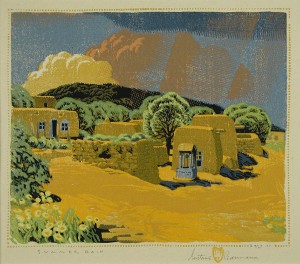Summer Rain

Beyond its atmospheric quality and evocative illusion of light and shadow, color plays an additional and important role in Gustave Baumann’s Southwestern landscapes: the overlapping of color impressions in this print produces perspectival depth, allowing the eye to better perceive space as rendered on the two-dimensional picture plane.
Baumann carved a total of six blocks to create this image—each carrying a different portion of the composition—and unlike most artists, who printed colors from light to dark, he followed the opposite sequence, beginning with black and then adding lighter colors. Working from a gouache drawing quickly executed during one of his drawing trips to sites of great natural beauty in the Southwest, Baumann proceeded to visually dissect the composition, breaking it down to the components he assembled to make the drawing in the field, and distributing the different elements of the final composition onto the various blocks.
This print is accompanied by a series of progressive proofs—which are rarely printed and preserved in their entirety—offering a valuable glimpse into the artist’s methodology and process.
Baumann first visited New Mexico in the summer of 1918, and quickly settled (as did several other artists who fell in love with the light in the area) in Santa Fe, where he continued to live and draw inspiration from the surrounding landscape throughout his career. For over fifty years Baumann practiced a traditionally European technique to illustrate an essentially American subject, the Southwest, developing his own distinctive aesthetic and becoming a pioneer in the field.
Kelley Tialiou ’10
Curatorial Assistant and Tour Coordinator